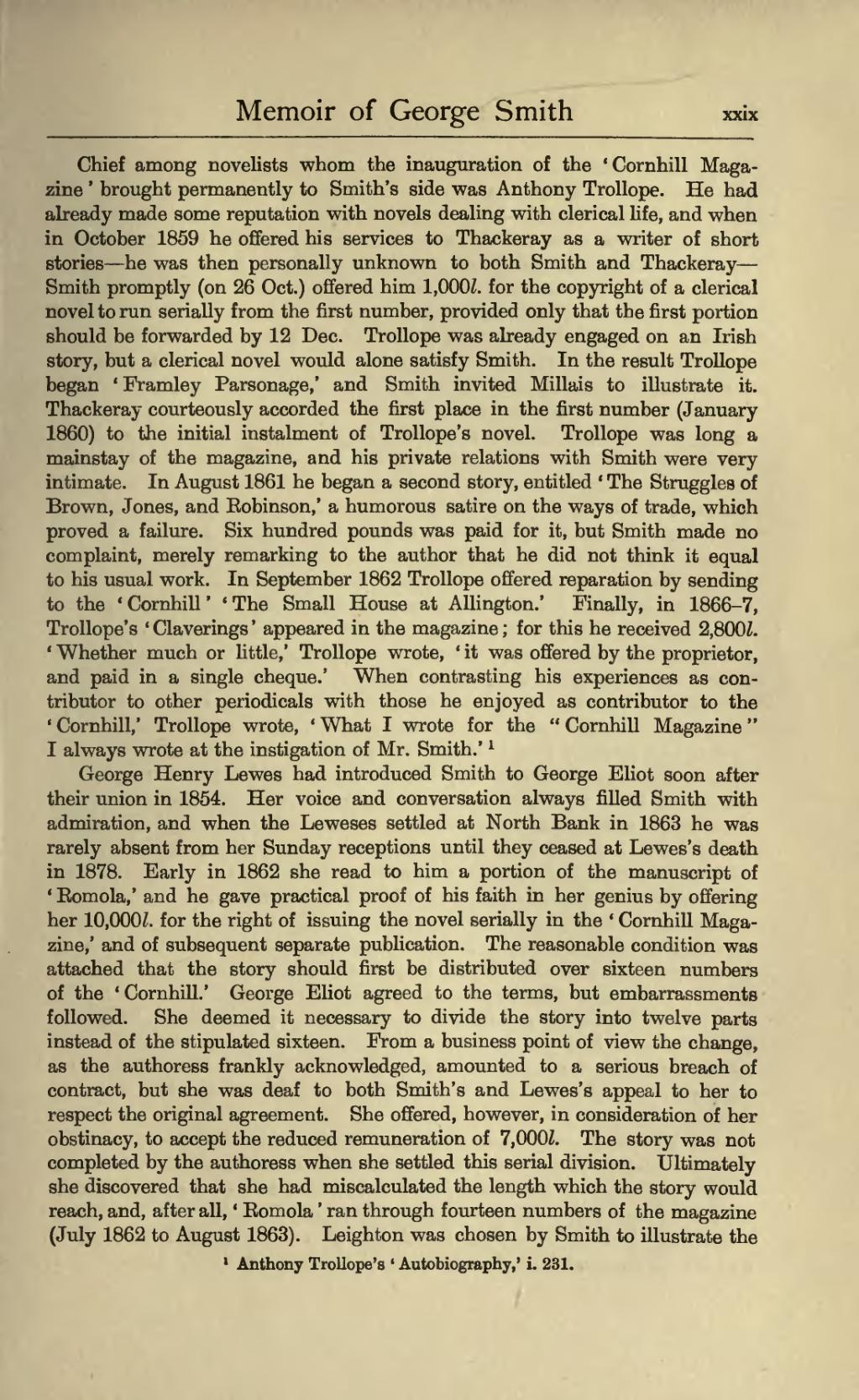Chief among novelists whom the inauguration of the 'Cornhill Magazine' brought permanently to Smith's side was Anthony Trollope. He had already made some reputation with novels dealing with clerical life, and when in October 1859 he offered his services to Thackeray as a writer of short stories—he was then personally unknown to both Smith and Thackeray — Smith promptly (on 26 Oct.) offered him 1,000l. for the copyright of a clerical novel to run serially from the first number, provided only that the first portion should be forwarded by 12 Dec. Trollope was already engaged on an Irish story, but a clerical novel would alone satisfy Smith. In the result Trollope began 'Framley Parsonage,' and Smith invited Millais to illustrate it. Thackeray courteously accorded the first place in the first number (January 1860) to the initial instalment of Trollope's novel. Trollope was long a mainstay of the magazine, and his private relations with Smith were very intimate. In August 1861 he began a second story, entitled 'The Struggles of Brown, Jones, and Robinson,' a humorous satire on the ways of trade, which proved a failure. Six hundred pounds was paid for it, but Smith made no complaint, merely remarking to the author that he did not think it equal to his usual work. In September 1862 Trollope offered reparation by sending to the 'Cornhill' 'The Small House at Allington.' Finally, in 1866-7, Trollope's 'Claverings' appeared in the magazine; for this he received 2,800l. 'Whether much or little,' Trollope wrote, 'it was offered by the proprietor, and paid in a single cheque.' When contrasting his experiences as contributor to other periodicals with those he enjoyed as contributor to the 'Cornhill,' Trollope wrote, 'What I wrote for the "Cornhill Magazine" I always wrote at the instigation of Mr. Smith.' [1]
George Henry Lewes had introduced Smith to George Eliot soon after their union in 1854. Her voice and conversation always filled Smith with admiration, and when the Leweses settled at North Bank in 1863 he was rarely absent from her Sunday receptions until they ceased at Lewes's death in 1878. Early in 1862 she read to him a portion of the manuscript of 'Romola,' and he gave practical proof of his faith in her genius by offering her 10,000l. for the right of issuing the novel serially in the 'Cornhill Magazine,' and of subsequent separate publication. The reasonable condition was attached that the story should first be distributed over sixteen numbers of the 'Cornhill.' George Eliot agreed to the terms, but embarrassments followed. She deemed it necessary to divide the story into twelve parts instead of the stipulated sixteen. From a business point of view the change, as the authoress frankly acknowledged, amounted to a serious breach of contract, but she was deaf to both Smith's and Lewes's appeal to her to respect the original agreement. She offered, however, in consideration of her obstinacy, to accept the reduced remuneration of 7,000l. The story was not completed by the authoress when she settled this serial division. Ultimately she discovered that she had miscalculated the length which the story would reach, and, after all, 'Romola' ran through fourteen numbers of the magazine (July 1862 to August 1863). Leighton was chosen by Smith to illustrate the
- ↑ Anthony Trollope's 'Autobiography,' i. 231.
